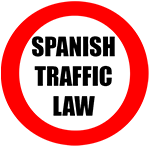1. The agents of the traffic authority who are regulating the traffic should be easily recognisable at a distance, both day and night, and their signals must be visible, and the users of the route must immediately obey their orders.
The agents of the traffic regulation authority and the Military Police, construction workers and escorts of special transport vehicles, who regulate the passage of vehicles and, in its case, the school patrols, the personnel of civil protection and that of organisations of sports activities or of any other act, authorised for the purposes contemplated in section 4 of this article, shall wear garments of striking colours and devices or retro reflective elements that allow drivers and other road users who approach them to distinguish them at a minimum distance of 150 metres.
Failure to heed the signs of personnel who are on the road supervising works, an action or sporting event will be grounds for minor sanctions. While not obeying the signs of traffic authority agents is considered a serious infringement and involves the withdrawal of 4 points of a driving licence.
2. As a general rule, the agents of the traffic authority will use the following signals:
A) Arm raised vertically: All road users approaching the agent must stop, except drivers who cannot do so in unsafe conditions. If this signal is made at an intersection, it does not force drivers who have already entered it to stop.
The stop must be made at the nearest stopping point or, failing that, immediately in front of the agent. At an intersection, the driver must stop before entering.
After this signal, the agent may indicate, where appropriate, the place where the stop must be made.
B) Arm or arms extended horizontally: All road users approaching the agent from directions that intersect the one indicated by the arm or extended arms and whatever the direction of their movement must stop. This signal remains in force even if the agent lowers their arm or arms, as long as they do not change position or make another signal.
C) Use of a red or yellow light: All road users that the agent directs the light at must stop.
D) Extended arm moving alternately from top to bottom: This signal indicates that vehicles approaching the agent on the side corresponding to the arm that executes the signal must slow down.
E) Other signs: when circumstances so require, agents may use any other indications different from the previous ones.
Agents may order the detention of vehicles with a series of short and frequent whistle blows, and the driver may resume their movement after hearing a long whistle blow.
3. Agents may give orders or instructions to users while using the V-1 signal established by the General Vehicle Regulations, through the public address system or by any other means that may be clearly perceived by them, among which there are the following:
A) Red flag: indicates that from the passage of the vehicle that carries it, the road is temporarily closed to the passage of all vehicles and users, except for those who are accompanied or escorted by the agents of the authority responsible for the regulation, management and control of traffic.
B) Green flag: indicates that, after the passage of the vehicle that carries it, the roadway is again open to traffic.
C) Yellow flag: indicates to drivers and other road users the need for maximum attention or the proximity of a danger. This flag may also be used by authorised auxiliary personnel who perform order, control or safety functions during bicycle races or any other activity, sporting or not, on the routes subject to traffic legislation, vehicle circulation to motor and road safety.
D) Arm extended down inclined and fixed: Used from a moving vehicle, the agent is indicating the obligation to stop on the right side to those users to whom the signal is directed.
E) Red or yellow light flashing or flashing forward: From a vehicle, the agent indicates to the driver of the one preceding them that they must stop the vehicle on the right side, in front of the police vehicle, in a place where there is no greater risk or inconvenience to other road users, and following the instructions given by the agent through the public address system.
4. In the absence of usual traffic agents or to assist them, and under the circumstances and conditions established in this regulation, the Military Police and the road works personnel, and those accompanying vehicles in a special transport regime may regulate the passage of vehicles through the use of R-2 and R-400 vertical signs incorporated into a paddle, and, by this means, school patrols can use it to stop movement. When the competent authority authorises the celebration of sporting activities or acts that require limitations to the movement in urban or interurban roads, the authority responsible for traffic may enable the civil protection personnel or the responsible organisation to prevent the access to vehicles or pedestrians to the affected area or itinerary, in the terms of Annex II.
When the State Security Forces and Corps, within the scope of their functions, establish controls for public safety on public roads, they may regulate traffic exclusively in the absence of traffic agents.
The form and meaning of the signals and orders of the traffic agents will be adjusted to what is established in the official catalogue of traffic signs. These signs are also included in Annex I.

